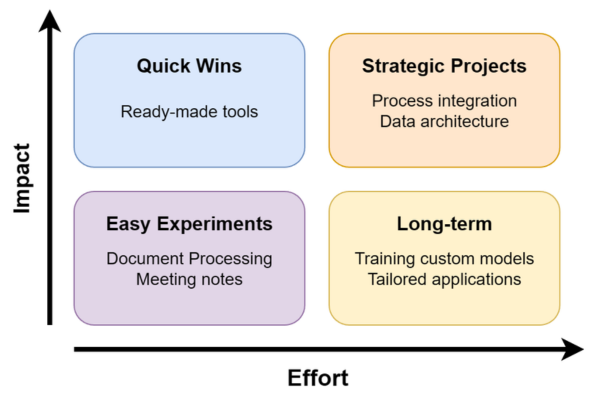Generative AI is the biggest productivity opportunity in decades, yet our new report for AIming for Productivity? project reveals a stark reality: 60% of Finnish SMEs aren’t using it at all.
While Finland is a European leader in AI adoption, this is driven almost entirely by large corporations. In West Finland, only 10% of SMEs use AI regularly. The cost of this inaction is massive: a five-year delay in adoption could slash Finland’s potential GDP growth by billions.
This post distills the findings from our “Aiming for Productivity?” project report into a no-nonsense roadmap to get started.
What’s Really Holding You Back?
It’s not just money. Our research identifies that the problem is deeper and more complex.

The two primary blockers are:
- The Skills Gap: A massive 68% of companies cite a lack of skills as their main roadblock. Locally, AI competence is the
#1 development need for South Ostrobothnian companies.
- Lack of Strategy: 46% of SMEs feel they get “no business benefit” from AI. This is a classic symptom of adopting tools without a clear business goal.
Where the Value Is (Right Now)
Generative AI doesn’t just analyze data; it creates content and code. This capability creates immediate efficiency, such as a 14% boost in customer service cases handled per hour.

Based on our regional pilots, here is where local industries should focus:
- Manufacturing: Focus on predictive maintenance and automated quality control. Our pilots successfully used AI to detect discrepancies in order forms and identify optimal saw-blade change times.
- Food Industry: Utilize AI for supply chain traceability, demand forecasting to reduce waste, and predicting raw material prices.
- Services: Automate routine admin and customer service. Smart chatbots and document analysis offer the fastest return on investment.
Your 5-Step Roadmap
You don’t need a team of data scientists. You need a disciplined approach to prioritizing your efforts.

- Start with “Quick Wins” Don’t build custom models yet. Use the Impact vs. Effort matrix above and start with “Easy Experiments”—like summarizing meeting notes or processing documents using ready-made tools like Copilot or ChatGPT.
- Train Your Leadership The skills gap is the biggest barrier. Change must be led from the top; leadership needs “AI literacy” to steer the strategy.
- Fix Your Data AI is only as good as the data it’s fed. Start breaking down data silos today. Warning: Never pilot without a baseline. If you don’t measure the “before,” you can’t prove the “after”.
- Set One Simple Rule As of 2024, only 11% of Finnish companies had any documented instructions for AI use. Create a one-page rule immediately: “Never put sensitive customer or financial data into a public AI tool”.
- Don’t Go It Alone Leverage the ecosystem. Networks like the Finnish AI Region (FAIR) and EDIHs exist specifically to help SMEs with low-cost expertise and testing.
The Bottom Line
The biggest risk in the age of AI is standing still.
Generative AI is a massive equalizer. Research shows it creates the biggest productivity boosts for employees with less experience, improving the quality of lower performers by 43% (compared to 17% for top performers). It levels up your entire team.
You don’t have to be an expert to start. You just have to start.
Ready to take the next step?
- Contact us: Learn more about the AIming for productivity? project and how we can help your business: https://projektit.seamk.fi/alykkaat-teknologiat/vailla-tuottavuutta/
This blog text was created as part of the AIming for productivity? project that received co-funding from the European Regional Development Fund (ERDF).
(Transparency Note: Consistent with our topic, this report and this blog post were produced with the support of AI tools for ideation, editing, structure, and visualization.)


